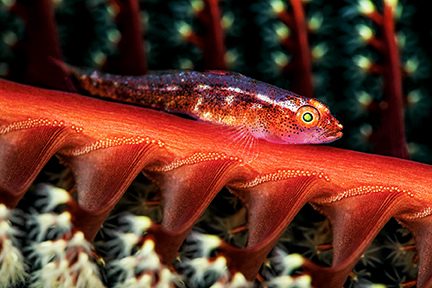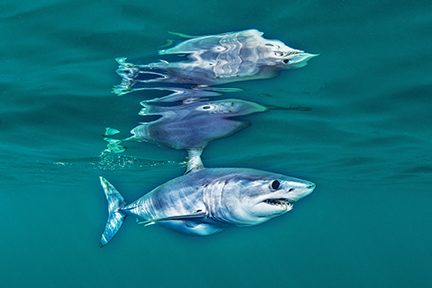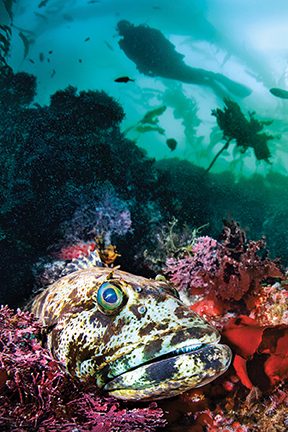UNDERWATER PHOTOGRAPHERS SPEND ENORMOUS AMOUNTS OF TIME, energy, and money pursuing subjects. We often select our dive destinations with specific subjects in mind. Sharks or manta rays may send us in one direction, lush reefscapes direct us in another, and macro critters or blackwater subjects will point us in yet another. This strategy for capturing stunning photographs makes sense — a phenomenal central subject is often a large part of what makes a shot. But it takes more than a great foreground to create a truly standout image. The potential impact of even the most spectacular subject can rapidly diminish when positioned against an unattractive, cluttered, or awkward backdrop.
We connected on Instagram, and I became more familiar with his vision’s excellence and eclectic nature with each We don’t talk much about backgrounds in underwater photography, but we should. The unsung hero, the strongest supporter of a fabulous image’s subject, is a flawless background. A great background will frame and emphasize your subject, can provide a sense of environment, might introduce secondary subjects, and may sometimes even tell a story. A great background elevates an image and takes it from, “Wow, neat frogfish,” to, “Holy cow, what an incredible frogfish shot!”
BACK TO BASICS
Photographic composition isn’t the topic of this article, but it’s impossible to effectively discuss backgrounds without touching upon a few applicable composition basics. One of the biggest pitfalls for photographers occurs when the excitement of discovering a great subject overtakes proper attention to how the subject is emphasized and positioned within the frame.
For our purposes, contrast is a biggie. The viewer should be able to easily identify the subject. Aside from proper lighting and focus on the subject, contrast is one of the best ways to ensure this happens. A common way to achieve contrast underwater is by getting lower than your subject and shooting upward; this often helps distinguish your subject from its habitat.
Subject placement is also essential. The use of classic rules such as the rule of thirds (positioning an image’s focal point at an imagined intersection of equally spaced pairs of vertical and horizontal lines — think of a grid resembling a tic-tac-toe board) and the rule of space (providing inferred “swim space” by leaving ample room ahead of the subject’s movement direction) can naturally guide photographers toward improved backgrounds. In addition, the use of leading lines atau S-curves, which can help guide a viewer’s eye around an image, can be compelling components of an engaging backdrop.



ABOVE LEFT: This image of a common goby is elevated by its location among the perfectly arranged branches of his vibrant sea pen home.
ABOVE RIGHT: The contrast of the blue water emphasizes this mako shark, and the proximity of the glass-calm surface allowed the photographer to also capture the mako’s reflection.
LEFT: The placement of the primary subject in this image, a lingcod, illustrates the rule of thirds, with the fish’s eye situated at the lower left of the frame. The inclusion of the animal’s habitat — a lush kelp forest — and addition of a diver’s silhouette as a secondary subject creates for the viewer a sense of both environment and scale.
A POSITIVE APPROACH
TO NEGATIVE SPACE
Negative space, defined as the empty space behind or around a subject, can be a powerful compositional tool. The use of a stark, simple background automatically attracts attention to the subject because there’s nothing else in the image to compete with it. The most popular illustration of this in underwater photography is a subject surrounded by a black background (the black part being the negative space). Photographers often achieve this effect by using external light sources and a high shutter speed to photograph a subject surrounded by open water on most or all sides.
The black background is usually applied to small subjects, although you can also use it beautifully with larger ones in dark conditions. The technique itself is simple to apply if you can identify and focus on a properly positioned subject — think of a critter on top of a rock or a passing creature during a blackwater dive. Because it delivers elegant, crisp images that are universally appealing, it’s sometimes worth spending some time during your dive looking for well-situated subjects.
Even when open water doesn’t surround a subject, it may still be possible to feature it against a black background by using a snoot. This tube fits over the end of an external light source and gives the shooter better control over the light’s radius and direction. These contraptions vary in complexity and cost, ranging from a simple pipe coupling from the local hardware store to more sophisticated systems using light-focusing lenses or fiber-optic technology. It can be challenging to execute a great snooted image, but it’s certainly worthwhile for a great subject with an otherwise so-so background. Although snoots are typically a macro tool, they can also selectively light items in a wide-angle scene and help highlight your subject within a busy or unappealing location.
Photographers don’t need to restrict themselves to a black background to showcase a striking use of negative space. If there’s adequate light in the water column, photographers create a blue or green water background by slowing the shutter speed, widening the lens aperture, and shooting at an upward angle. Bokeh, a shallow depth-of-field effect created by using a wide aperture to blur the background, is a great way to introduce unique negative space to a macro portrait of a great subject in an imperfect environment. The bokeh approach can even allow for unique backgrounds. Angling your lens toward a subject above a white sand seafloor may allow you to get a light-colored background, whereas angling your lens toward a nearby colored sponge or a branch of brightly colored soft coral might provide a hued background.
You can sometimes improve even the busiest background by introducing purposeful motion blur, an advanced technique that uses a slow shutter speed while panning the camera.

LEFT: Soft coral is a favorite subject of many shooters. In this image, the upright position of a colorful, shallow branch of soft coral leads the viewer’s eye toward the background, which includes sunrays filtering through the overhanging foliage. By aiming the camera at an upward angle, the photographer has also incorporated the edge of Snell’s window, faintly visible on the upper right side of the image.
LOCATION, LOCATION, LOCATION
Another striking way to showcase your subject is by capturing it in an attractive setting. There’s often an element of luck to this type of image, especially in wide-angle scenarios, so knowing the environment and preparing to photograph your subject in a way that captures the beauty of the area is critical. Using your camera’s light meter can aid this process, but nothing beats taking a few test shots as soon as you enter the water (as well as each time your depth or the ambient light changes notably) to ensure that you can capture the shot you’re envisioning.
When the scenery is especially lovely, even the most common subject is well worth photographing. An unconventional but productive method for smaller subjects is to first look for an attractive backdrop, and then inspect the area for a commensal creature. Identifying a colorful anemone or a perfect branch of soft coral, for example, and searching for any fish or invertebrates that occupy the space can earn you some spectacular shots.
You can apply a similar approach to wide-angle images. A passing school of fish, a cavern opening with penetrating sunrays, or a wall covered with colorful cup corals should send background aficionados searching for a foreground subject.
Unique opportunities for a great background exist if your subject is in very shallow water. In calm conditions, the opportunity may arise to capture a reflection of your subject against the surface. For larger subjects or when using a wide-angle lens, angling upward may allow you to capture unique topside elements, including clouds, overhanging foliage, or people.
If conditions are ideal and you’re able to shoot toward the sky, it may be possible to incorporate Snell’s window into your background. This optical phenomenon results from refraction at the air/water boundary that manifests as a circular image of the entire above-water hemisphere. It provides a distinctive appearance that is well worth the effort to capture.
SUPPORTING ROLES
Including a secondary subject is a great way to add impact to an image. This common approach assimilates objects such as a sunburst, other marine life (including multiples of your main subject), or a diver into the background. A diver gazing at an adjacent subject or silhouetted high in the frame are common illustrations of this technique. Adding a diver as a secondary subject enhances the composition, creates relatability, and affirms that your primary subject is exciting — after all, the diver in your image is also viewing it.
Secondary subjects can also provide context; situations such as implied predation (such as a lionfish with a school of baitfish in the background) or reproduction (such as a damselfish guarding a nest) are highly desirable scenes to capture.
Adding a secondary subject can be tricky. It’s critical to guide the viewer’s gaze from the primary subject to the secondary subject and back again. Differences in focus or size are often good ways to lead the viewer and differentiate your subjects. The main subject should command an initial response from the viewer through sharp focus or larger size in the frame relative to a more softly focused or smaller secondary subject.
Photographers often spend their dives searching for spectacular subjects, and that’s as it should be. But remembering to take the time and effort to optimize the backdrop is a significant step to displaying a subject at its best. A photograph’s background may seem ancillary, but it’s a critical component of an image that can instantly improve or diminish the overall effect.
© Penyelam Siaga — Q2 2022